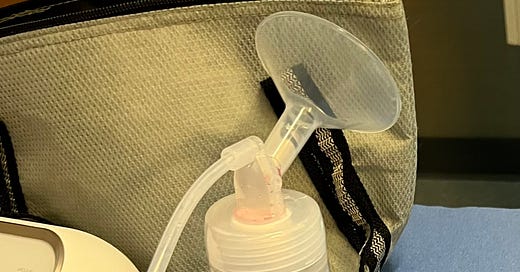Picture this: you’re getting ready to discharge a new mom home and she calls you in a panic—she just pumped for her baby who is in the NICU and… pink milk!? Maybe even a little red rust-colored? Before she has an anxiety attack and throws in the nursing towel, have her take a deep breath. Blood in breast milk is much more common than you think, especially in the first week or so—and usually, it's not dangerous for baby or mom.
Let’s break it down, what’s normal, what’s not, and when to be concerned.
Why Is There Blood in the Milk?!
First things first: milk isn’t always going to be white. Milk can be blue-ish, yellow (hey there, colostrum), even orange-ish. So if you spot a pink tinge, that’s often just a little blood making a guest appearance.
Here are the usual suspects:
Rusty Pipe Syndrome
This is the #1 reason for bloody milk in the first few days. As the breasts gear up to make milk, the milk ducts go through a growth spurt, and tiny blood vessels may leak a bit. The blood mixes with colostrum and voilà—strawberry milk.
Usually shows up in the first week
Self-resolves in a few days
Totally safe to feed the baby!
Cracked Nipples
Ouch. Cracks, blisters, or trauma from a shallow latch or pump can lead to visible blood.
Solution: Observe the feeding. Check for a deep latch and check for anything unusual about baby’s mouth. If mom is pumping, observe a pumping session, adjust the flange size or the vacuum settings as needed. Mom should be able to pump without any pain. Between pumping or feeding, have her apply a nipple ointment or hydrogel pad.
When mom is discharged, be sure she has an appointment with someone who can continue to support her until the situation is resolved. Worth a visit from a local IBCLC!
Broken Capillaries
Did mom go a little hard on the pumping? Or perhaps her newborn had a long vigorous feeding session? Friction or strong suction can break tiny vessels in the breast. Usually nothing serious—but if it’s recurring, time to adjust technique.
Less Common But Important
If blood keeps showing up for more than a week, is accompanied by pain, swelling, or a lump that won’t budge, it could be a sign of:
Mastitis or abscess
Intraductal papilloma (a benign growth in the duct)
Rarely, something more serious like cancer
Mom should be instructed to call her provider if the blood in milk lasts more than 48 hours or occurs suddenly later in her breastfeeding journey.
But Is It Safe for Baby?
Short answer: YES. Baby can safely nurse on blood-tinged milk. It might make their poop a little darker—no cause for alarm. Some babies may spit up a bit more, or (rarely) fuss at the taste. But just because baby can have the blood-tinged milk, doesn’t mean mom will want to give it. If the blood is a small amount noted the nipple, most mothers are comfortable continuing with breastfeeding. If however, mom has pumped milk and it is significantly bloody, most mother’s in my experience, do not feel comfortable feeding that milk to baby. The choice is hers, of course.
(This milk was pumped on day 5. Mom had a nipple abrasion and blister. This resolved completely in 24 hours. Mom did not feed this milk to baby.)
How Can I Help?
Encourage mom to keep breastfeeding if the baby is latching well and content and nipples are not too sore
Observe and correct latch as needed
Encourage cool compresses and gentle massage if engorged
Instruct mom to get IBCLC help ASAP if her nipples are damaged
Pumping? Check flange fit and suction levels
The Bottom Line
Blood in breast milk looks scary—but it’s usually harmless, temporary, and doesn’t mean the milk is “bad” or unsafe. The body is doing big, beautiful work, and sometimes that includes a little internal drama.
Mom needs to know that if she is ever in doubt, she should reach out to an IBCLC or to her healthcare provider. Remember, breast milk is still amazing—even if it’s a little pink!





Mary: I love the way you write... making it simple and easy to understand!! I especially love the "Rusty Pipe Syndrome"